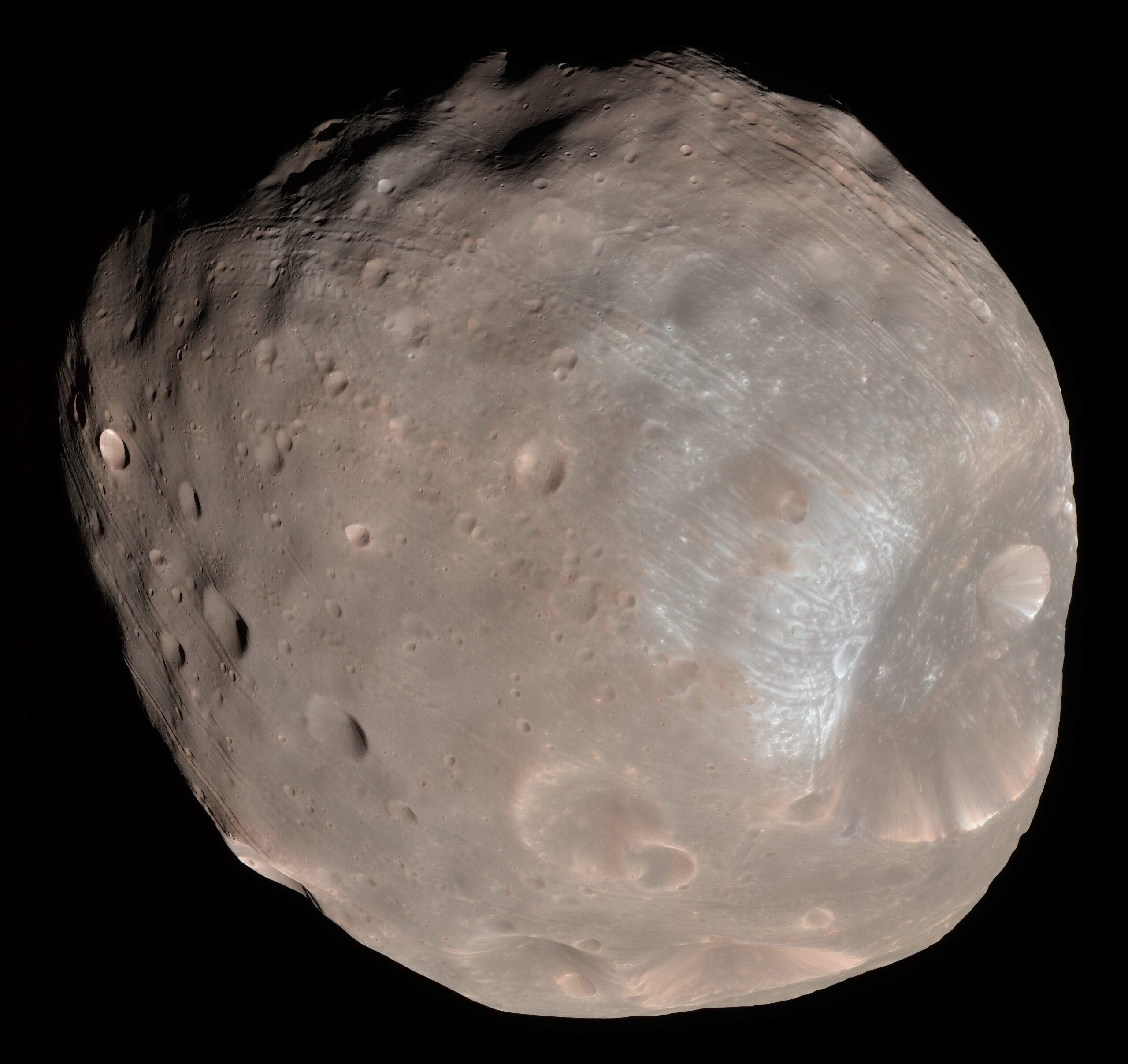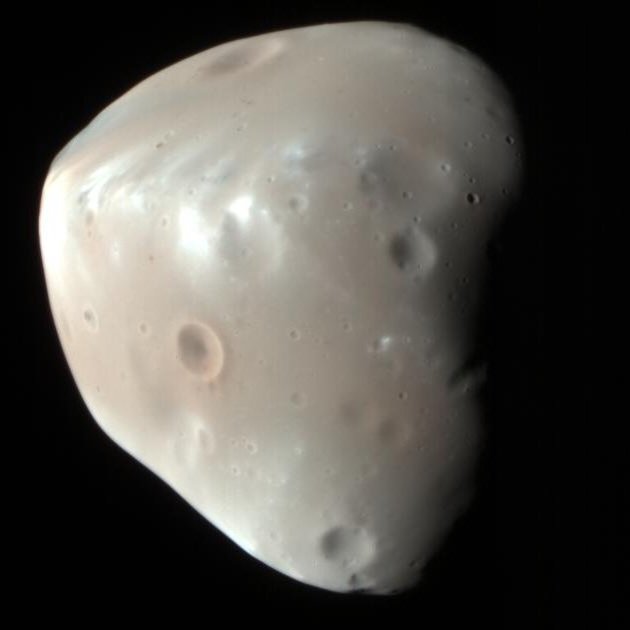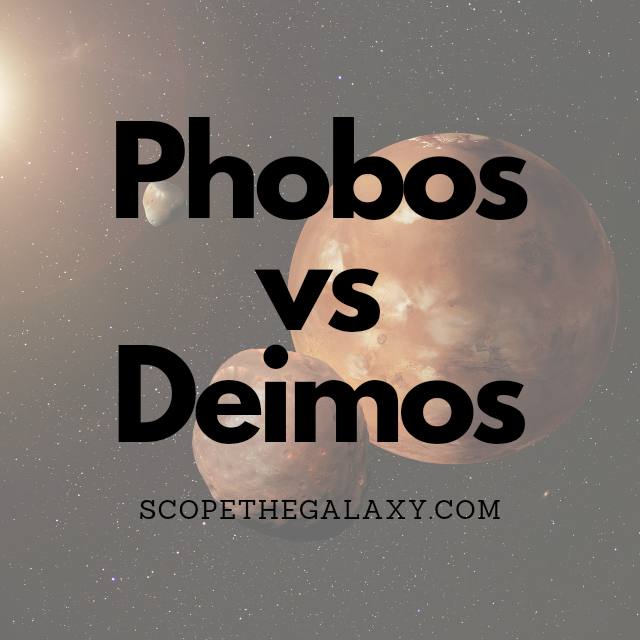*This post may contain affiliate links. This means we may make a commission if you purchase an item using one of our links*
Mars has two moons; Phobos and Deimos. These satellites are tiny (even the larger one has a diameter that is 100 times smaller than Earth’s moon) and orbit their planet at an incredibly close range. Sculpted by meteorite impacts, these moons are irregularly shaped and incredibly dark (which is why they weren’t discovered until the 19th Century).
Continue reading to discover the key features of these two satellites. Though they are incredibly similar, some key differences can help differentiate the two, as we learn the future fate of Phobos and Deimos.
What Is The Moon Phobos?
Table of Contents

Phobos is the larger and innermost of the Martian moons, named after the Greek God of fear and panic. This rocky satellite measures approximately 27 x 22 x 18 kilometers and possesses an irregular shape.
Flying only 270 km above Mars’s surface, Phobos orbits the Martian surface so closely that it spins around the planet three times a day (each orbit takes 7 hours and 39 minutes). And this proximity means that the moon cannot always be seen from Mars’ surface (it all depends on where you’re standing).
In general, Phobos rises in the west, passes through the sky in around 4 hours, and sets in the east. And this process occurs twice during one Martian day.
Phobos travels 1.8 m closer to Mars every 100 years, which means this doomed moon will one day crash into its planet or break up into rings. Still, this won’t happen for another 50 million years or so.
The moon is covered in streak patterns from impact craters, the most significant of which is the crater Stickney, with a diameter of 9.7 km. Phobos has weathered thousands of meteorite impacts, one of which almost shattered it to pieces.
It was first discovered by the American astronomer Asaph Hall on 17th August 1877. But, it can be difficult for astronomers to see as it is one of the least reflective bodies in the solar system with an albedo of 0.071.
Despite its small stature, Phobos experiences wildly varying temperatures on its dark side compared to the light side. Measurements on the light side of the moon suggest that temperatures can rise to -4 degrees Celsius, a sort of brisk winter’s day that would be cold but tolerable.
In contrast, temperatures on the dark side can drop to -112 degrees Celsius, even though the two areas are just a few kilometers apart. The probable cause is fine surface dust that cannot retain heat, allowing temperatures to drop rapidly.
The low density of Phobos suggests its composition is similar to carbonaceous chondrite meteorites, which could mean that Phobos is a captured asteroid.
What Is The Moon Deimos?

Deimos is the smaller and outermost of the two moons of Mars, named after the Greek God of dread and terror (the brother of Phobos). This satellite was also discovered by American astronomer Asaph Hall just five days before Phobos (12th August 1877).
Scientists like Johannes Kepler had put forward theories for the existence of these moons many years before they were discovered. Their calculations were based on the fact that the planets on either side (Earth and Jupiter) possessed one and four moons, respectively.
Still, none were discovered until the 19th century. One of the main reasons for this is that the tiny size of Phobos and Deimos, combined with an exceptionally close orbit to their planet, means that the glare of Mars often obscures our view of them.
Phobos measures just 15 x 12 x 11 km and completes an orbit of Mars once every 30 hours.
This tiny moon is also a heavily cratered landscape shaped by the impact of asteroid collisions over time. However, the material thrown up from these impacts doesn’t appear to have landed back on the moon’s surface as it usually would. This could be because the lack of gravity on Phobos allowed the ejected material into space.
The surface gravity on Deimos is just 0.003 m/s^2 (compared to 9.807 m/s^2 on Earth), which means the average gravitational pull of Deimos is only 0.003 m/s. With only 1/2500th of Earth’s gravity, you would need a tether to walk on this rocky moon, or every step would put you at risk of achieving escape velocity and launching yourself into space.
The composition of Deimos is similar to Phobos, suggesting that it might also be a captured asteroid. Its surface is very dark gray and has an albedo of around 0.07, meaning it reflects just 7% light (about half of the light Earth’s moon can reflect).
Similarities Between Phobos And Deimos
- Phobos and Deimos are both Martian moons
- They are both small moons with close orbits to their central planet
- Both have cratered surfaces caused by thousands of meteorite impacts throughout their history
- Both possess an irregular shape
- They both have a carbonaceous composition, which suggests they could be captured asteroid-like bodies
- Both are named after the sons of the Greek war God Ares
- Both have an albedo of around 0.07, which means they have meager reflection rates
- Gravity is extremely weak on both moons (roughly 1/1000th of Earth’s moon on Phobos and 1/2500th of Earth’s moon on Deimos), which means even a step or a jump on these satellites could launch you into space
- The temperatures are similar on both moons, running from -4 degrees Celsius on the light sides to a freezing -112 degrees Celsius on the dark side
- Both were discovered in the 19th century by American astronomer Asaph Hall
Differences Between Phobos And Deimos
- Phobos is locked in a “death spiral” with Mars, meaning that the two will collide at some point, whereas Deimos orbits further from the planet and is actually moving away from Mars. Eventually, Deimos will escape into space
- Phobos is larger and closer to the planet – it rises and sets twice during a single day on Mars. Deimos is smaller and takes around 30 hours to complete a single orbit
Summary
Phobos and Deimos are the twin moons of Mars, potentially asteroid-like bodies captured by Mars and pulled into the planet’s orbit. Both are small, irregularly shaped bodies with low gravity. And they both have dark surfaces and experience wild temperature fluctuations.
Still, Phobos is the larger moon locked on a death spiral that will eventually lead to its collision with Mars, whereas Deimos is smaller and traveling away from the planet where it will one day escape back into space.
References
In-Depth | Phobos – NASA Solar System Exploration
Phobos | moon of Mars | Britannica
In-Depth | Deimos – NASA Solar System Exploration
Deimos | moon of Mars | Britannica


